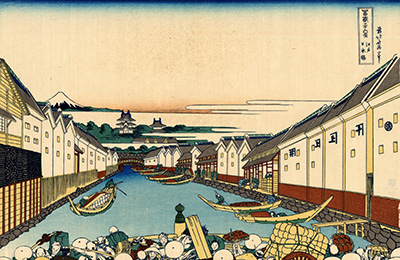Hokusai
Nihonbashi bridge in Edo by Hokusai
Nihonbashi Bridge in Edo is a woodblock print in ink and colour on paper. It was produced between 1830-1832 and is 10inches tall by 14.5 inches wide. It depicts a landscape image of the central district of Edo and the Nihonbashi Bridge.
The composition is interesting in that the image appears to be cropped and you wouldn’t be alone in believing the image had been altered on your screen but it hasn’t this is how it was painting. It is believed the thought behind this is to give the impression of you being part of the scene, scrambling among the bustling crowds as they attempt to cross the bridge. The chaotic scene makes the bridge itself barely viable, you can only make it out if you look very closely at the bottom of the piece and note the finial attachment on the gate post.
Katushika Hokusai was born in Edo (present-day Tokyo) Japan in approximately October 1760 he is most famous for the woodblock series Thirty-six views of Mount Fuji. His artistic career can be split into blocks. His career began at 12/14 when he worked as an apprentice woodcarver for Katsukawa rowShunsho, during this period he focused mainly on producing images of famous people of the time.
At the end of the 1700s moved on to painting landscapes and still life images of daily Japanese life, this was a turning point in his career which lead to his widespread acclaim and fame. In the first 15 years of the 1800s he produced many books including an illustrated series and a series of art manuals. In 1820, he changed his name to ‘Litsu’ it was quite common in Japan at this time for people to often change their names and he was known by 36 different names in his lifetime. It was during this period that he created his most famous works including Thirty-Six views of Mount Fuji, Great Wave off Kanagwa and Nihonbashi Bridge in Edo.
